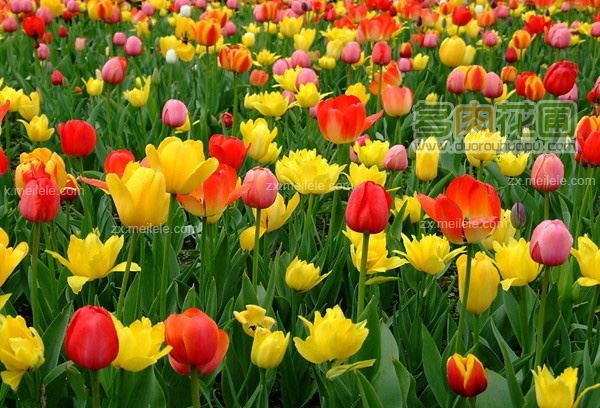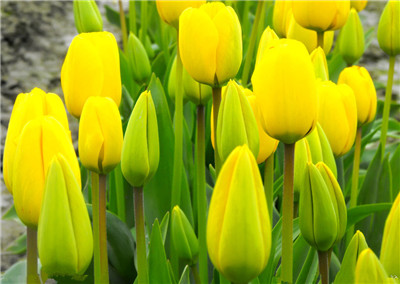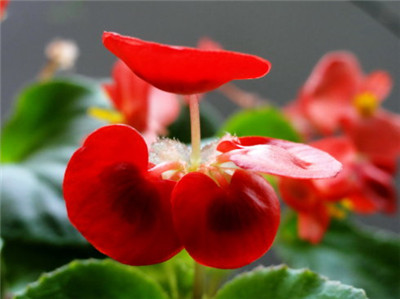How to produce tulips by water culture
Tulip is a perennial herb of Liliaceae, which is very popular because of its large flowers and colorful flowers. It is widely used in the fresh cut flower market. Now, the production of hydroponic cut flowers is gradually welcomed by professional growers. China began to introduce and cultivate tulips in the 1990s. The following aspects should be paid attention to in the production of tulips by hydroponic culture.
1. Selecting suitable and disease-free bulbs is the key to hydroponic production of cut tulip flowers.
2. After the seed balls are shipped back, they must be stored in a cold storage that has been debugged. The temperature is 5 degrees Celsius and the humidity is less than 80%. Check and select the seeds with serious penicilliosis in time.
3. According to the time needed, select and determine the cultivation time and planting mode. For hydroponic cut flower cultivation, the bulb should be planted in a sterilized and watertight needle plate, so that the rooting temperature is stable at 8 degrees Celsius and the humidity is between 60% and 70%.
4. Take root for about two weeks, make sure the root length is more than 3 cm, and transport the needle plate to the greenhouse. The temperature is controlled at 15-20 degrees Celsius and the humidity is 60%-70%. The EC value in the water is 1.5ms to 2.0 ms by adding nutrient solution to facilitate the rapid growth of tulips.

Through the previous understanding, we all know that tulips belong to the perennial herbs of Liliaceae, and are loved by many people. Because it is very popular in the market, various countries have devoted themselves to studying its cultivation techniques, and the production of hydroponic cut flowers is gradually welcomed by professional growers. Introduction and experimental cultivation began in China in the 1990s. At present, the domestic experience of hydroponic culture is mainly as follows: 1. Select bulbs, which is the key to hydroponic production of cut tulip flowers, so bulbs are suitable and disease-free. 2. After the seed balls are transported back to the place of hydroponics, they are stored in a cold storage with a temperature of 5 ℃ and a humidity of less than 80%. The seed balls with serious penicilliosis are checked and selected in time. 3. According to the time required, select and determine the cultivation time and planting mode. For hydroponic cut flower cultivation, the bulb should be planted in a sterilized and watertight needle plate to stabilize the rooting temperature at 8 ℃ and the humidity between 60% and 70%. 4. Take root for about two weeks, make sure the root length is more than 3 cm, and transport the needle plate to the greenhouse. The relevant conditions of the greenhouse are as follows: the humidity is 60% to 70%, the EC value in the water is 1.5ms to 2.0 ms, and the temperature is controlled at 15% 20 ℃, which is beneficial to the rapid growth of tulips. 5. The initial stage of growth is very vulnerable to diseases, so in the initial stage of growth, in order to prevent diseases caused by filamentous bacteria, it can be sprayed 2 to 3 times. Low toxicity, topiramate, high efficiency chlorothalonil, trimethoprim and so on were selected, and the concentration was between 750 and 1000 times. 6. according to the growth situation, foliar fertilizer is sprayed timely to coordinate vegetative growth and reproductive growth. 7. In the process of growth, due to the action of root exudates and other environmental conditions, a layer of oil film will be produced on the water surface of the needle disk, which will make the root lack of nutrient supply and cause the root system to be brown. Therefore, change the water for 2 to 3 times as appropriate. 8. when the harvested cut flowers are not sent away in time, they must be placed in a cool and ventilated place to avoid strong light, high temperature and low temperature, which will affect the quality of cut flowers. Conclusion: with the continuous development of the times, the cultivation techniques of plants are more and more, some from soil cultivation to hydroponic culture. This is the case with tulips, and every cultivation method is witnessing the progress of the times. The above production methods of tulip hydroponics can be used for reference! More Information | what does White Rose mean | Plant Anti-computer radiation | Geranium | Rhododendron Culture methods and precautions | Lavender florescence | Indoor foliage plants | Parthenocissus | Lilium foliage | efficacy and function of mint | Culture method of mimosa | | how to raise succulent plants | Osmanthus | gynostemma pentaphyllum | hand-made roses | efficacy and function of honeysuckle | Kumquat |
Can tulips be cultured in water? tulips can be cultured in water.
Some people may know something about hydroponic flowers, but did you know that tulips can be hydroponically cultivated? Next, we will tell you about the method of tulip hydroponics.
Can tulips be hydroponically cultivated?
Water culture method of tulips:
1. Seed bulb selection: selecting a suitable and disease-free seed bulb is the key to the hydroponic production of cut tulip flowers. Hydroponic tulips need to be cold treated. The temperature is controlled at 9 ℃ before the end of October, and the temperature is kept at about 2 ℃ from December to January, and the humidity is 85-95%.
2. Planting method:
① chooses and determines the cultivation time and planting method according to the time it takes. For hydroponic cut flower cultivation, the bulb should be planted in a sterilized and watertight needle plate to stabilize the rooting temperature at 8 ℃ and the humidity between 60% and 70%.
② takes root for about two weeks, make sure the root is more than 3 cm long, and transport the needle plate to the greenhouse. The relevant conditions of the greenhouse are as follows: the humidity is 60%-70%, the EC value in the water is 1.5ms to 2.0ms, and the temperature is controlled at 15-20 ℃, which is beneficial to the rapid growth of tulips.
③ is very susceptible to diseases at the initial stage of growth, so in order to prevent diseases caused by filamentous bacteria, it can be sprayed 2 to 3 times. Low toxicity, topiramate, high efficiency chlorothalonil, trimethoprim and so on were selected, and the concentration was between 750 and 1000 times.
According to the growth condition, ④ sprays foliar fertilizer timely to coordinate vegetative growth and reproductive growth. In the process of growth, due to the action of root exudates and other environmental conditions, a layer of oil film will be produced on the water surface of the needle disk, which will make the root lack of nutrient supply and cause the root system to be brown. Therefore, change the water for 2 to 3 times as appropriate.
3. Culture medium: the planting plate is placed in a rooting chamber with a small amount of air flow at a temperature of 5 ℃. Tap water with a conductivity of 1.5ms/cm or Rain Water can be used. For varieties prone to leaf cracking, water with a conductivity of 2ms/cm should be used in the rooting stage.
4. Maintenance: when the tulip root grows to 100px, put the planting plate on the flat ground in the greenhouse to remove the susceptible or ungerminated bulbs. At this stage, make sure that the water level reaches the overflow outlet, the temperature is maintained at 16-18 ℃, and the humidity is maintained at 60-80%. The frequency of watering at the end of planting can be reduced to half of that before harvest, and enough water should be provided to the plant before harvest to prolong the flowering period of tulips.
More information
- Prev

Key points for the conservation of commercial flower tulips
Tulips are more and more widely used in commodities, and more and more flower growers grow tulips. Tulips are a relatively delicate flower species. If you want to grow tulips well, you must pay attention to scientific planting methods. Prepare the matrix. In order to prepare a high quality matrix, it is required that the water should be preserved and breathable, and the salinity should not be too high or too sour.
- Next

How to raise four seasons begonia in summer
Begonia is the most common and cultivated species of begonia. The four seasons crabapple has beautiful posture, bright green leaves, clusters of flowers, gorgeous and dignified flowers, more delicate against the green leaves, it is a good ornamental plant, and the flowers are open all the year round, with a slight fragrance, used to decorate the room.
Related
- Fuxing push coffee new agricultural production and marketing class: lack of small-scale processing plants
- Jujube rice field leisure farm deep ploughing Yilan for five years to create a space for organic food and play
- Nongyu Farm-A trial of organic papaya for brave women with advanced technology
- Four points for attention in the prevention and control of diseases and insect pests of edible fungi
- How to add nutrient solution to Edible Fungi
- Is there any good way to control edible fungus mites?
- Open Inoculation Technology of Edible Fungi
- Is there any clever way to use fertilizer for edible fungus in winter?
- What agents are used to kill the pathogens of edible fungi in the mushroom shed?
- Rapid drying of Edible Fungi

